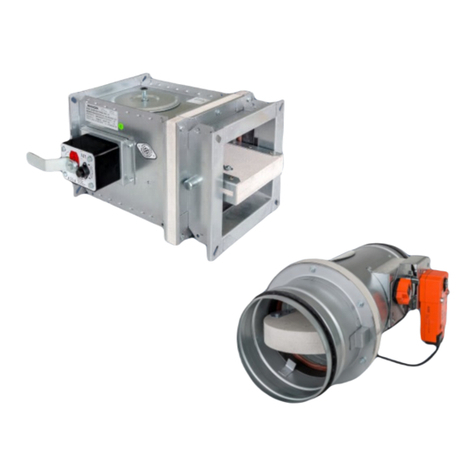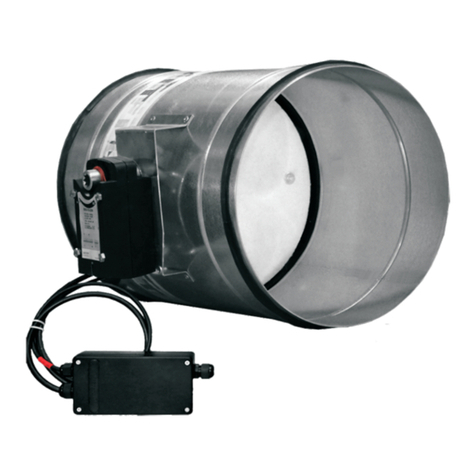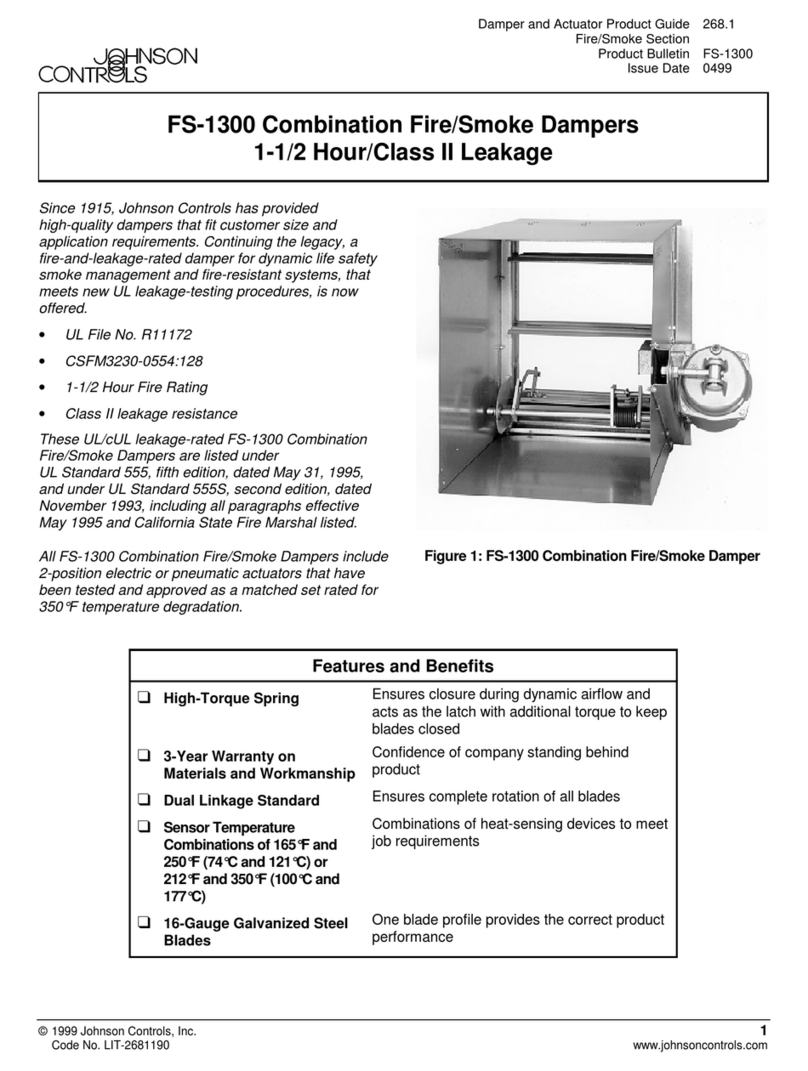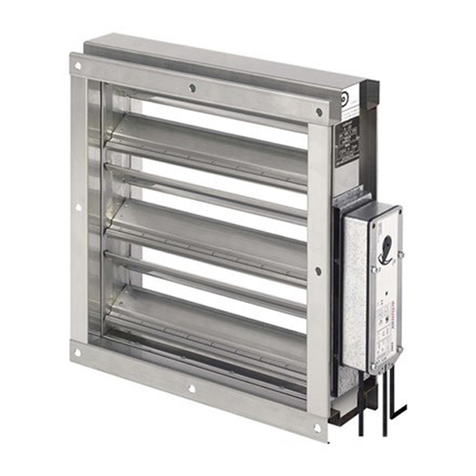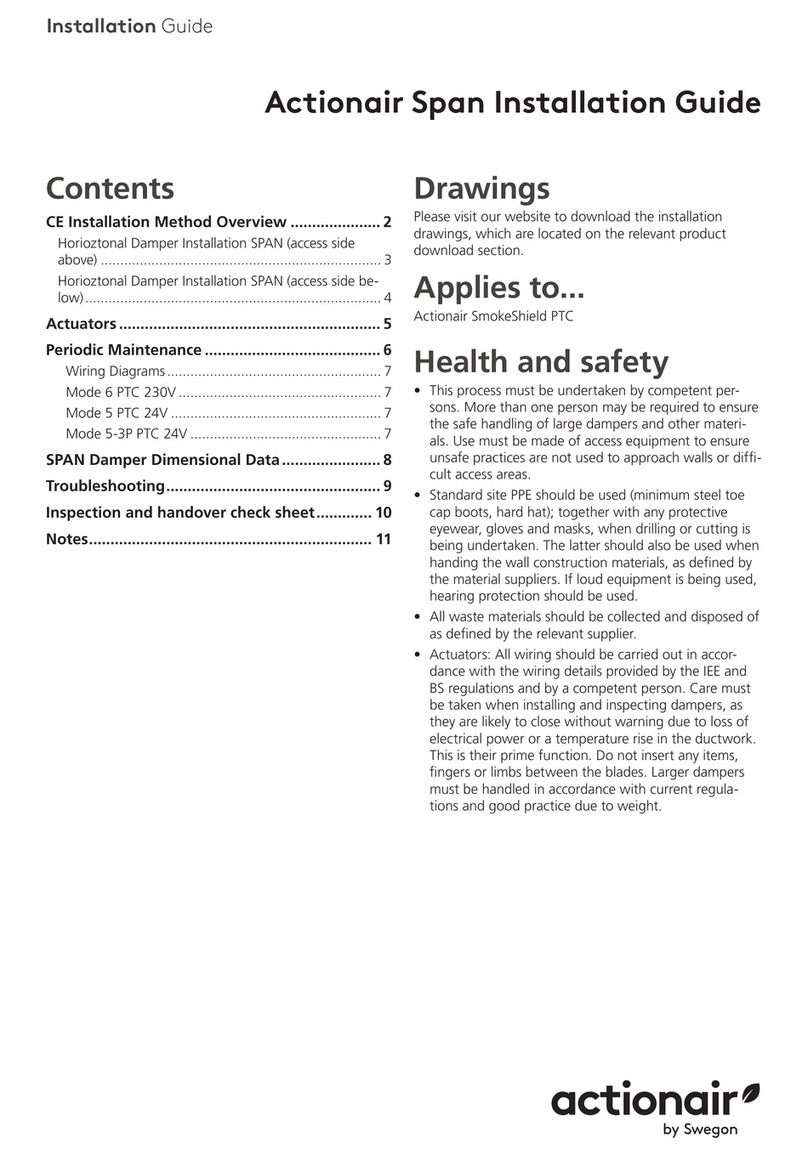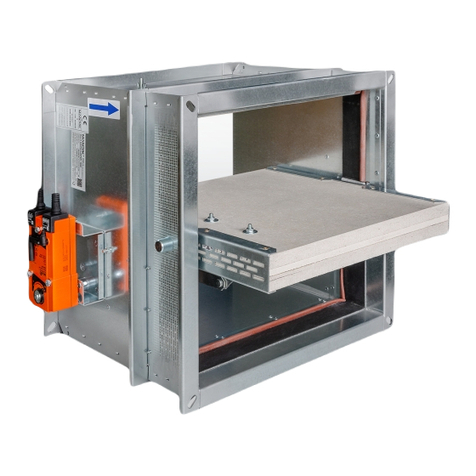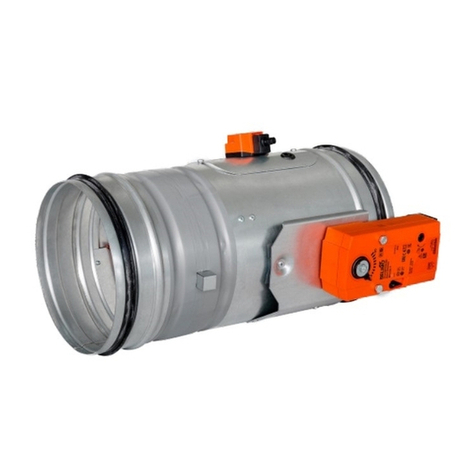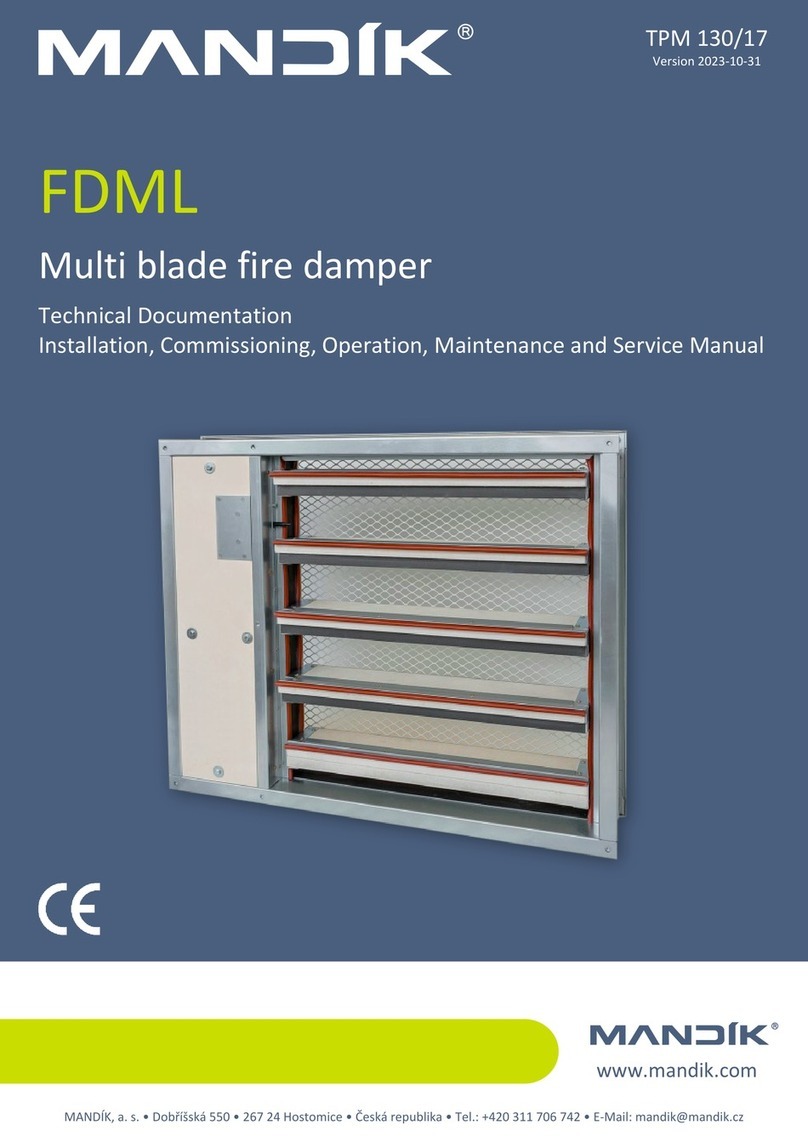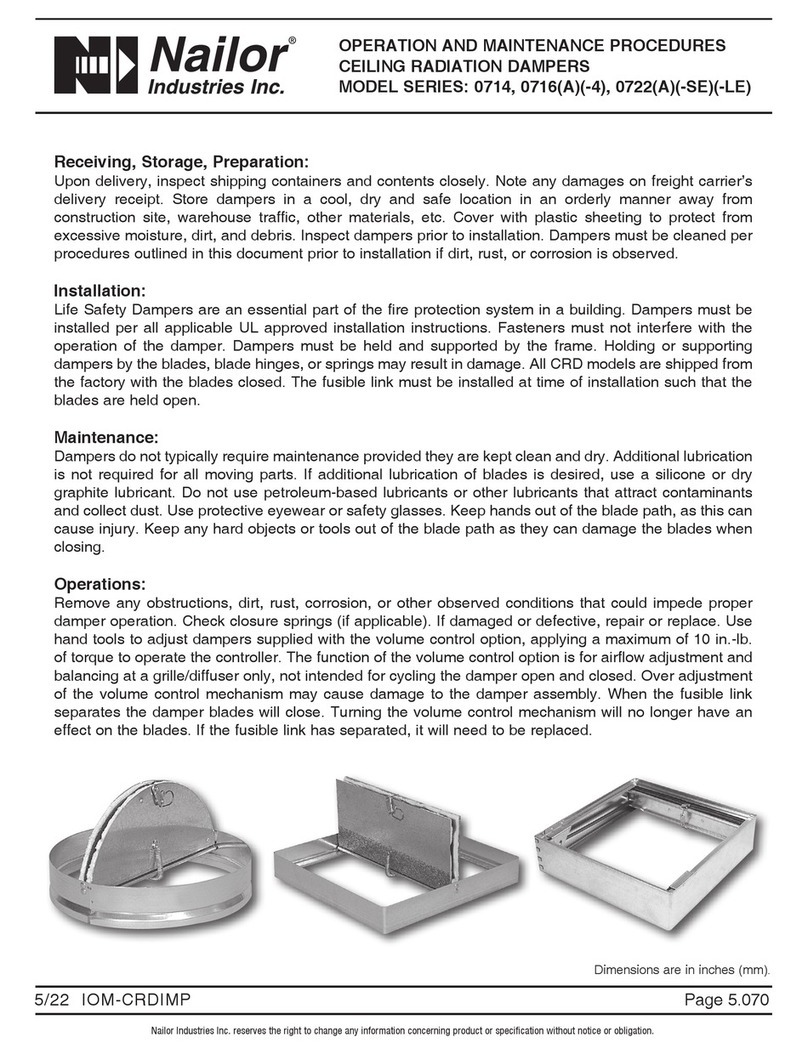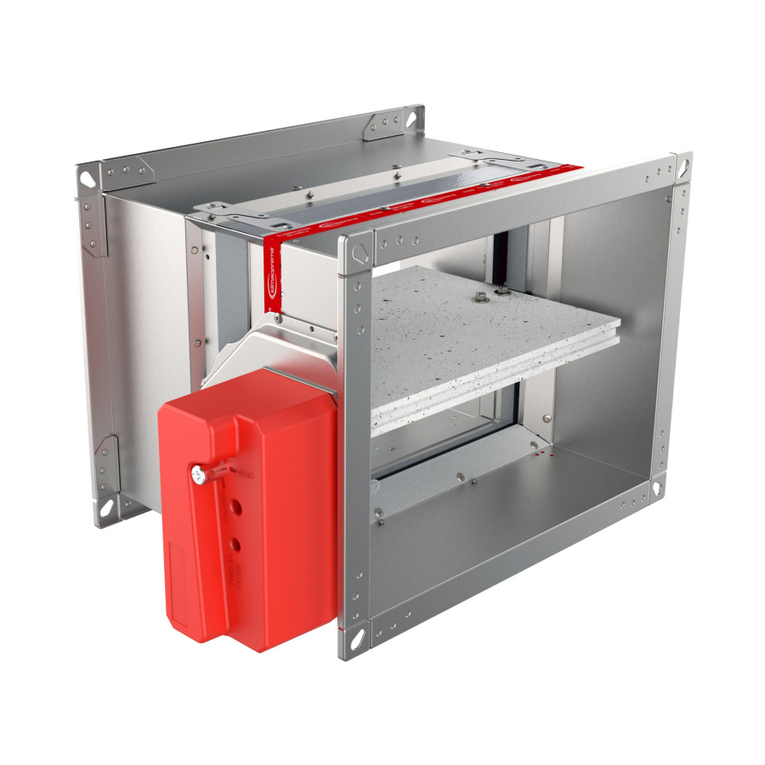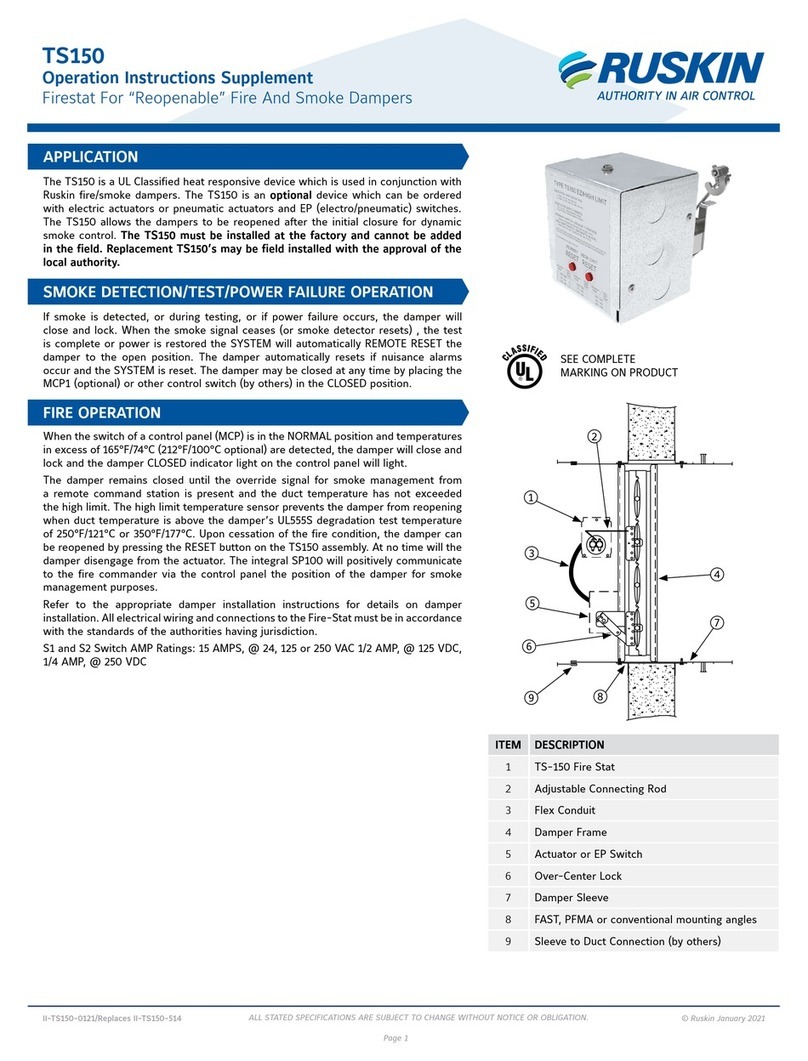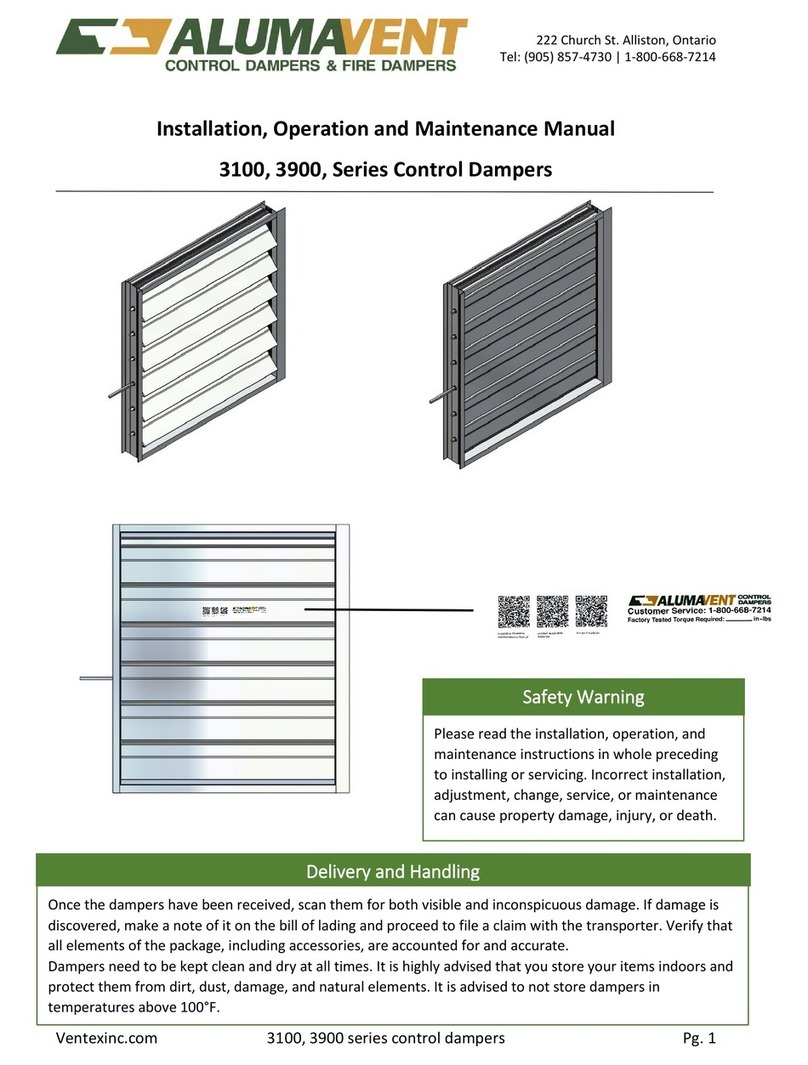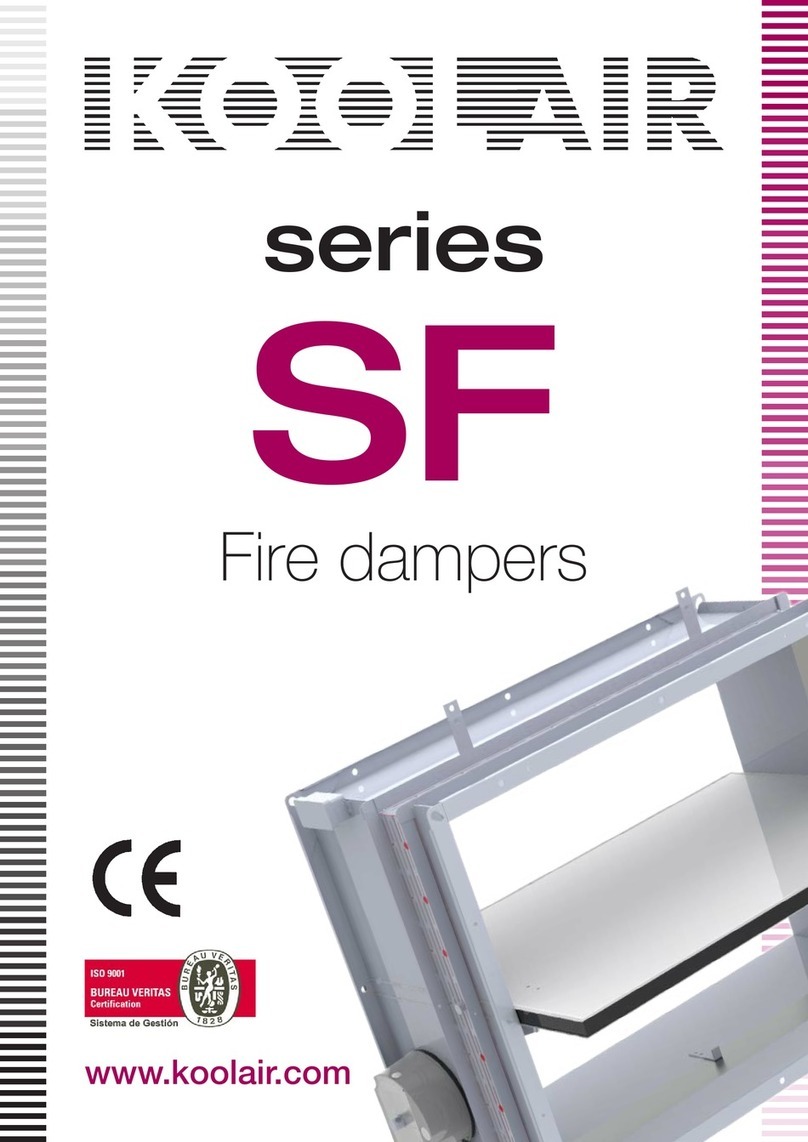Bredel Pulsation damper Series User manual

Pulsation damper series
PD/40, PD/65 and PD/100
Manual
ORIGINAL INSTRUCTIONS

2
© 2020 Watson-MarlowBredelB.V.
All rights reserved.
The information provided herein maynot be reproducedand/orpublished in anyform, by print, photo
print,microfilmor any other meanswhatsoever (electronicallyor mechanically) without the prior
written authorization of Watson-MarlowBredelB.V.
The information provided can be changed without priornotification. Watson-MarlowBredel B.V. or
one of its representatives cannot be held liable forpossible damageresulting fromuse of this manual.
This is an extensive limitation of the liability which applies to alldamage, inclusive of (without
limitation) compensating, direct,indirector consequential damage, loss of data, income or profit, loss
or damage to possessions and claimsof third parties.
Watson-Marlow Bredel B.V. provides the information in this manual “as is” and does not take any
responsibility and does not give any guarantee on this manual or its content. Watson-MarlowBredel
B.V. rejects all responsibilities and guarantees. Furthermore,Watson-MarlowBredel B.V. does not
take responsibility for and does notguaranteethat information in this manual is accurate, completeor
up to date.
Names, trade names, brands, etc. used by Watson-MarlowBredel B.V. may not, as per the legislation
concerning the protectionof trade names, be considered as available.

3
CONTENTS
CONTENTS..................................................................................................................................... 3
1GENERAL .............................................................................................................................. 4
1.1 Howto use this manual.................................................................................................. 4
1.2 Original instructions........................................................................................................ 4
1.3 Service and support........................................................................................................ 4
1.4 Environment and disposal of waste................................................................................. 4
2SAFETY.................................................................................................................................. 5
2.1 Symbols......................................................................................................................... 5
2.2 Intended use.................................................................................................................. 5
2.3 Compliance Pressure Equipment Directive...................................................................... 5
2.4 Use In Potentially Explosive Environments (ATEX).......................................................... 5
2.5 Responsibility................................................................................................................. 6
2.6 Qualification of the user.................................................................................................. 6
2.7 Regulations and instructions........................................................................................... 6
3WARRANTY CONDITIONS..................................................................................................... 7
4DESCRIPTION........................................................................................................................ 8
4.1 Identification of the product............................................................................................. 8
4.2 Operation ofthe pulsation damper.................................................................................. 8
4.3 Pulsation damper hose................................................................................................... 9
4.4 Pulsation damper selection........................................................................................... 10
5INSTALLATION AND COMMISSIONING.............................................................................. 11
5.1 Unpacking.................................................................................................................... 11
5.2 Inspection.................................................................................................................... 11
5.3 Installation conditions................................................................................................... 11
5.3.1 Ambient conditions............................................................................................ 11
5.3.2 Set-up............................................................................................................... 11
5.4 Lifting and moving the pulsation damper....................................................................... 12
5.5 Setting the pulsation damper pressure level for operation.............................................. 12
6MAINTENANCE.................................................................................................................... 14
6.1 Cleaning the pulsation damper hose internally.............................................................. 14
6.2 Removing the pulsation damper hose........................................................................... 14
6.3 Replacing the pulsation damper hose........................................................................... 15
6.4 Checking the Pressure relief valve................................................................................ 16
7TROUBLESHOOTING.......................................................................................................... 17
8SPECIFICATIONS ................................................................................................................ 18
8.1 General information...................................................................................................... 18
8.2 Torque values.............................................................................................................. 18
8.3 Weights........................................................................................................................ 19
8.4 Dimensions.................................................................................................................. 19
8.5 Spares list.................................................................................................................... 20
1.2 Surface treatment......................................................................................................... 21
9DECLARATION OF INCORPORATION OF PARTLY COMPLETED MACHINERY ............... 22
10 SAFETY FORM .................................................................................................................... 23

4
1 GENERAL
1.1 How to use this manual
This manual is intended as a reference book by means of which qualified users areable to install,
commission, operate and maintain the pulsationdampers mentioned on the front cover.
1.2 Original instructions
The originalinstructions for this manualhave been written in English. Other languageversionsof this
manualare a translation of the originalinstructions.
1.3 Service andsupport
For information with respect to specific adjustments,installation, maintenance or repair jobswhich fall
beyond the scope of this manual, contact your Bredelrepresentative.Make sure you havethe
following information at hand:
serial number pulsation damper
type number pulsation damper
You will find this data on the identification plate of the pulsationdamper (see paragraph
4.1 Identification ofthe product).
1.4 Environment anddisposal of waste
Enquire within your local government about the possibilities for reuse or environment
friendly processing of packagingmaterials, (contaminated)lubricant and oil.
Always observe the localrules and regulationswith respectto processing (non-
reusable) partsof the pulsation damper

5
2 SAFETY
2.1 Symbols
In this manual the following symbolsare used:
WARNING
Procedures which, if not carried out with the necessary care, may result in serious
damage to the pulsation damper or in serious bodily harm.
CAUTION
Procedures which, if not carried out with the necessary care, may result in serious
damage to the pulsation damper, the surroundingarea or the environment.
Remarks, suggestions and advice.
Procedures, remarks,suggestions or advisewhich refer to use in potentially
explosive atmospheres(ATEX) in accordance with European guideline 2014/34/EU.
2.2 Intendeduse
The pulsation damper is exclusively designed for thedamping of pulses on the dischargeside of a
Bredelhose pump. After consultationwith your Bredel representative, andonly on certain conditions,
the pulsation damper maybe used asa pressure relief valve.Every other or furtheruse isnot in
conformance with the intended use1. Themanufacturercannotbe held responsiblefor anydamage or
harmresulting fromthis. The pulsation damperis designed in conformance with the currentEuropean
standards and directives. Only use the pulsation damperin conformance with the intended use
described above. If you want to change the application of your pulsationdamper, contact yourBredel
representative first.
1The “intended use” as laid dow n in NEN-EN-ISO 12100 is “…the use for w hich the technical product is intended in
accordance withthe specifications of the manufacturer, inclusive of his indications in the sales brochure”. In case of
doubt it is the use whichappears to be its intended use judging from the construction, execution and function of the
product. Observing the instructions in the user’s documentation also belongs to intended use.
2.3 Compliance Pressure EquipmentDirective
The pulsation dampersasmentionedon the front cover are in full compliance with the European
Pressure Equipment Directive 2014/68/EU.
2.4 Use In PotentiallyExplosive Environments (ATEX)
The pulsation dampersPD/40, PD/65 and PD/100 can be used in a potentially explosive atmosphere
(ATEX). The pulsation damper isnot classed asATEXequipment since it contains no ignition source

6
fromits own. It is considered aspart of the pump and the ATEXcode for the pump is applicable,
meaning it can operate under the same ATEXenvironment as the pump it isattached to. In general
this means the damper is suitable for Group II, category 2 and temperature class T4.
When operating under ATEXpay extra attention to the following:
Pulsation Damper to be installed, operated and maintained accordingthismanual (see chapter
8 SPECIFICATIONS).
Make sure the damper isconnected to the earth. In generalthisis the case when the damper is
connected to the pump and the piping system. Byconstruction allparts are electricallyconnected.
This can be checked bymeasuring the electrical resistance to the earth. The electrical resistance
to any ground connectionshould be less than 1 MOhm.
WARNING
In case it is not possible to create an earth/groundconnection with less than 1 MOhm,
one should make an additional PE (protective earth)connection to the pulsation
damper. (see chapter 5 INSTALLATIONANDCOMMISSIONING).
2.5 Responsibility
The manufacturer does not acceptany responsibility for damage or harmcausedby not (strictly)
observing the safety regulations and instructions in this manual or bynegligence during installation,
use, maintenance and repairof the pulsationdampers mentioned on the frontcover.Depending on
the specific working conditions or accessories used, additional safety instructions can be required.
Immediately contact your Bredel representative, if you notice a potentialdangerwhile using your
pulsation damper.
WARNING
The user of the pulsation damper isalwaysfully responsible for observing the local
valid safety regulations and directives.Observe these safetyregulations and
directives when using the pulsation damper.
2.6 Qualificationof the user
The installation, operationand maintenance of the pulsation dampershould be carried out by well
trained and qualified users. Temporarystaffand persons in training may only use the pulsation
damper under the supervision and responsibilityof well trained and qualifiedusers.
2.7 Regulations andinstructions
Everyone who works with the pulsation damper must be aware of the content of this manualand
observe the instructions with great care.
Never change the order of the actionsto be carriedout.
Always store the manualnear the pulsation damper.

7
3 WARRANTY CONDITIONS
The manufacturer offers a two year warrantyon allpartsof the pulsation damper. This means thatall
parts will be repaired or replacedfree of charge with the exception of consumables, such as hoses
and seals, or parts which have been misused or have been intentionallydamaged. If parts are used
that are not Watson-MarlowBredel B.V. (hereafter calledBredel) parts, every warranty becomes void.
Damaged parts which are covered by the applicablewarrantyconditionscan be returned to the
manufacturer. Thepartsmust be accompanied by a fully filled in and signed safety form,aspresent in
the back of this manual.The safety formmust be applied to the outside of the shipping carton. Parts
which have been contaminated or which have been corroded by chemicals or othersubstanceswhich
can pose a health risk, mustbe cleaned before theyare returned to the manufacturer. Furthermore, it
should be indicated on the safety formwhich specific cleaning procedure has beenfollowed, and it
should be indicated that the equipment has been decontaminated. The safety formis requiredatall
items, even if the parts have not been used.
Warranties purportingto be on behalf of Bredel B.V.made byany person, including representatives of
Bredel, its subsidiaries, or its distributors, which do not accord with the terms of this warranty shall not
be binding upon Bredel unless expressly approved in writing by a Director or Manager of Bredel.

8
4 DESCRIPTION
4.1 Identification ofthe product
The pulsation damper and pulsation damper hose can be identified bythe contents of the
identification plate on the pulsation damperhousingand the hose label.
The identification plate of the pulsation dampercontains the following information, relevant for
identification:
A. Type
B. Serialnumber
C. Identification number of Notified
Body
D. Year of manufacture
The hose labelon the pulsation damper hosecontains following information:
A. Re-order number
B. Internaldiameter
C. Type of materialof inner liner
D. Maximum permissible working pressure
E. Production code
4.2 Operationof the pulsationdamper
The Bredel pulsation damper reducesthe pulsescreatedin the dischargeline bythe hose pump. This
is achieved by means of a thick-walled, reinforcedrubber hose which is mounted in a carbon steel,
cylindrical pressure vessel. The hoseis surrounded by compressed gas(airor nitrogen).
When a pressing shoe leaves the pump hose, while rotating, instantly the volume in the discharge line
will increase with the volume of the pump hose nowreleased by the pressing shoe.This willresult in
a momentary deceleration of the fluid which results in a pressure dropin the discharge line.

9
When the discharge pressure drops, the pulsationdamper hose contracts and compensatesfor the
released volume of the pressing shoe in the dischargeline. The fluid deceleration is minimised and
the pulse will be reduced.
Depending on the application and size the damper can reducethe pulse by 50-90%. The damperis
most effective at a discharge pressureof 500 kPa or above. The pulsationdamperscan be
pressurized up to 1600 kPa. The pulsationdampers aresafeguarded for over-pressureby a
pressure-relief valve.
4.3 Pulsation damperhose
The pulsation damper hose linermaterial should be chemically resistantto the product to be pumped.
Dependent on the specific requirements of your application, a matching hose shouldbe selected.
A. Outer extruded layer made of natural rubber
B. Four nylon reinforcement layers
C. Inner extruded liner
For each pulsation damper,varioushosetypes are available.The material of the innerliner of the
hose determines the hose type. Each hose typeis marked bya unique colour code.
Hose
type
Material
Colour
code
Article number:
PD/40
PD/65
PD/100
NR
Naturalrubber
Purple
P040020
P065020
P100020
NBR
Nitrile rubber
Yellow
P040040
P065040
P100040
EPDM
EPDM
Red
P040075
P065075
P100075
Consultyour Bredelrepresentative for Hose Pumpsfor more
detailed information about the chemicaland temperature resistance
of pulsation damper hoses.
Store the pulsation damper hose in a cool, dry place and do not
subject it to sunlight.

10
4.4 Pulsation damperselection
The pulsation damper types mentioned on the front cover are functional with more than one type of
Bredel hose pumps. In the following table the right pulsation damper can be selected to match your
hose pump:
Selectiontable pumpand pulsationdamper
Pulsation damper
type:
Pump
type:
PD/40
Bredel 25, Bredel 32, Bredel 40
PD/65
Bredel 50, Bredel 65
PD/100
Bredel 80, Bredel 100
If you are in doubt about the correct installation of your pulsation
damper, contact your Bredel representative for assistance. They will
advise about the installation layout,pipe diameters, etc., to ensure
optimum performance of your pulsationdamper.

11
5 INSTALLATION AND COMMISSIONING
5.1 Unpacking
When unpacking carefully followthe instructionsas given on the packagingor on the pulsation
damper.
5.2 Inspection
Check that your delivery is correct and check it for any transport damage (seealso paragraph
4.1 Identification ofthe product).
5.3 Installation conditions
5.3.1 Ambient conditions
Make sure the ambient temperature, during normal operation of the pulsation damper, does notfallto
below -20°C, and does not exceed +45°C.
5.3.2 Set-up
When installing the pulsation damperconsiderthe following points:
The pulsation damper willnot be effective for variable pump speeds or variabledischarge
pressures.
Limit the presence of sharp bends. Make sure thatthe radius of the bentdischargeline is as large
as possible. It is recommended to use Y-connectionsinstead of T-connections.
The pulsation damper willbe most effective if it is directly mounted onto the hose pump. Minimise
the distance between pump and pulsation damper.
The pulsation damper may be installed in either the horizontal or verticalposition.
The pulsation damper must be suitably supported.
The pulsation damper must be electrically connected to earth. (Resistance less than 1 MOhm). If
required make a PEconnection to the pulsation damper. The PEwire can be connected to one of
the bolts attaching the flange bracketto the damperhousing.
If installed in a potentiallyexplosive atmospheres, properlyearth thepulsation
damper and respect the instructionsasmentioned in paragraph 2.4 Use In
Potentially Explosive Environments (ATEX)
Avoid, at all times, a pressure higherthan the maximumoperating pressure.
When using a Bredel series 265-2100 pump with pulsations over 500 kPa (5 bar, 72.5psi) use
two pulsation dampers - one for each pump head.

12
Avoid too heavyloads on the flanges. The maximumforces are given in the table below:
Maximum flange loads
Force
Unit
PD/40
PD/65
PD/100
F1
N
1000
1400
2000
lbf
225
315
450
F2
N
500
700
1000
lbf
112
157
225
F3
N
200
300
400
lbf
45
67
90
5.4 Lifting and movingthe pulsationdamper
To lift, move and position the pulsation damper, suitable hoistingbeltsmust be used. The best place
to attach the hoisting belts isimmediatelybehind both flangesofthe pulsation damper. Keep in mind
the pulsation damper’s weight. For weights see also paragraph8.3 Weights.
WARNING
If the pulsation damper isto be lifted, ensure that allsafety regulationsfor lifting
movements are adhered to and that the lifting is carriedout by qualified personnel
only.
5.5 Setting the pulsationdamper pressure level foroperation
The pulsation damper air or nitrogen pressure level must be set. This setting for maximum pulse
reduction depends on the process condition. Therefore the setting can only be obtained when the
pump is running atoperatingconditions.
It is advised to check the pressure relief valve functioning with each installation, hose replacement or
annually (which comes first). (See paragraph 6.4 Checking the Pressure relief valve.)
CAUTION
Consider the maximum allowable pressure. The maximumallowable pressure can
either be determined bythe pulsationdamper, pump or process. Exceeding the
maximum allowable pressure may lead to serious injuriesor damage to the pump and
the environment.

13
CAUTION
Consider the filling mediumfor the pulsation damper housing –in this case
compressedair or nitrogen.If in doubt concerning the correctfilling mediumfor
your pulsation damper, contactyour Bredelrepresentative for assistance.
CAUTION
Before pressurizing the pulsationdamper ensure that the pulsation damper is built in
the piping system, ensure that the suction and discharge valves areopen, ensure
that any drain valves are closed. (process releasedfor operation)
1. Shut the ballvalve (pos. 17) on the pulsation
damper.
2. Connect the filling mediumto the filling nipple (pos.
18).
3. Applypressure to the pulsation damperby the filling
medium. Minimum filling medium supply pressure
should at least be equal to the processworking
pressure directly upstreamof the pulsation damper.
4. Start the pump
5. Open the ballvalve (pos. 17) gently. Filling mediumwillnow enter and pressurize the vessel.
Check the pressure gauge(pos. 20)for the actual gas pressure pvinside the vessel.
6. Pressurize the vessel to approximately 80% of the actual fluid discharge pressure of the hose
pump (p2), close to the pulsation damper.
7. Continue to fillthe vessel with gas and closely watch the pressure pulsation on the manometer.
When the pulsation drops to a minimumthe required gas pressure is reached. Shut off the ball
valve (pos. 17). The pressure inside the vesselshould be within the indicated range shown in the
table below.
Vessel gas pressure pv
(reading gauge pos. 20)
PD size 40
p2 < pv<p2+ 2 bar
PD size 65
p2 < pv<p2+ 1,5 bar
PD size 100
p2 < pv<p2+ 1 bar
The gas pressure pvin the vesselmust notexceed 16 bar.
8. Shut off the supply pressure of the filling medium
Caution
The optimumvessel pressure is process specific. It is advised to slowly increase the
vesselpressure untilthe pressure fluctuations downstreamof the pulsation damper
are minimized and optimaldamping is obtained. The gas pressure pvmust not exceed
the design pressure psof 16 bar.
If the actualprocess working pressure is very low(for example during standstillor after
a transfer cycle iscompleted) it is advised to relief the pressure fromthe pulsation
damper.

14
6 Maintenance
Carefulmaintenance and,in particular, scrupulouscleaning areessential for problem-free operation
of the pulsation damper.
Before carrying out any maintenance to the pulsation damper,pleasethoroughlyacquaint yourself
with the directives in the chapter 2 SAFETY.
Any repair to the pulsation damperis to be carried outbyproperlyskilled and authorised users
only.
After cleaning and maintenancework, do not use the pulsation damperuntilall parts thathave
been removed, are reinstalled correctly.
WARNING
Release the pressure fromthe pulsation damperby means of the ball valve near the
pressure-relief valve, beforestartingon any work to the pulsation damper.
WARNING
Protect your hands and face fromany dangeroussubstanceswhen handling or
examining the pulsation damper hose.
CAUTION
After maintenance has been carried out, andbeforeswitching the pump back on,
ensure that allvalves present in the pipe work are opened.
6.1 Cleaningthe pulsationdamperhose internally
The inside of the pulsation damper hose iseasilycleanedbyflushing the pump and pulsation damper
with clean water.If a cleaning fluid is added to the water, it must be checked that the hose liner
material is resistant to that.
With many products to be pumped, it isnecessary to clean the pulsation damperhose
immediately once the pump is stopped, to avoid solidificationand hardening of the
product within the hose.
6.2 Removingthe pulsation damperhose
1. Disconnect the electricalsupply fromthe corresponding pump and close any valvesto minimise
product loss.
2. Position a tray under the pulsation damper. Thistray must be sufficientlylarge to collect all liquid
product inside the pulsationdamper.
3. Release allpressure fromthe pulsationdamper using the ballvalve (pos. 17).
WARNING
If the pulsation damper hose is cracked or worn, liquid productto be pumped may
escape via the ballvalve (pos. 17). Therefore,take the necessarysafety precautions.

15
4. Support the pulsation damperin such a way that it cannot fallduring disassembly.
5. Remove the mounting bolts fromboth flanges. Lift the pulsationdamper ontoa suitable
workbench.Adhere to the instructions for lifting and moving as mentioned in paragraph5.4 Lifting
and moving the pulsation damper.
6. Loosen the hose clamps (pos. 8) fromboth ends.
7. Unscrewthe bolts (pos. 11 and 12) fromboth flanges (pos. 9).
8. Unscrewthe locknut (pos. 7) on both sides untilthe compression on the pulsation damper hose
has relieved.
9. Remove both inserts (pos. 10) fromthe pulsationdamper hose.
10. Remove both metal rings(pos. 5 +6), O-rings (pos. 4) and neck-rings (pos. 3)
11. Remove the mounting bolts fromboth flange supports (pos. 9) together with the inserts (pos. 10).
12. Remove the pulsation damper hose fromthe housing.
6.3 Replacing the pulsationdamper hose
After the pulsation damper hose has been removed, as described in “Removing th e pulsation damper
hose”, the (new) hose can be installed in the pulsation damper.
CAUTION
If you are installing a newpulsation damper hose, and you wish to continue pumping
the same product, ensure that the colour code of the newhose matches the colour
code of the old, used hose.
1. Check all parts to be installed for anydamage and replace when necessary.
2. Grease allmetal parts which are not corrosion-protectedand O-rings with Molykote®55Mor
equivalent.
3. Place one of the collar bushes (pos. 3) in the damper housing.Installthe pulsation damperhose
(pos. 2). Place the second collar bush (pos.3).
4. Slide both O-rings(pos. 4) at both ends over thepulsationdamper hose.
5. Place both metal rings(pos. 5 + 6) and hand-tighten bothpressingrings (pos. 7).
6. Loosely place the hose clamps (pos. 8) at both ends.
7. Loosely place the flanges on both sides (pos. 9) and place the inserts. (pos. 10)
8. Tighten the pressing rings(pos. 7) (seealso paragraph 8.2 Torque values).
9. Tighten both flanges (pos. 9) using the corresponding boltsand spring washers.(pos. 11 and 12)
10. Lift the pulsation damper fromthe work bench and place it back into the pipe work. Observe the
instructions for lifting and moving as mentioned in paragraph 5.4 Lifting and moving the pulsation
damper.Mount and tighten the mounting bolts to the
flanges at both ends.
11. Shut the ballvalve (pos. 17) on the pulsation damper.
12. Connect the filling mediumto the filling nipple.
13. Applypressure to the pulsation damperby the filling
medium.
14. Open the ballvalve (pos. 17) gently. Filling medium
will nowenter and pressurize the vessel. Check the
pressure gauge (pos.20) forthe actual pressure
inside the vessel.

16
15. Pressurize the vessel to 1400 kPa (14 bar, 203 psi) above atmospheric. Bypressurizing the hose
will be stretched outwards,forcing the hose endsover the inserts.
16. Close the ballvalve.
17. Tighten both hose clamps (pos. 8) with the proper torquevalues.
The minimum required torquevalues as advised(see paragraph 8.2Torque values)
cannot always be realized in the field. Thisis due to the unknown friction between
tightening bolt and clamp. Especially in case ofused stainless steelclamps that are
not properlygreased.In such case the applied boltingtorquedoes not reflect the
required clamping force of the hose clamp.
So in case the minimum specified torque valuesare not sufficientit is advised to
increase the bolt torque until a sealed situation is obtained. Here the absolute torque
value is of lessimportance (althoughmaximumapplied bolting torques should remain
within the range specified (see paragraph 8.2 Torque values). It is advised to tighten
the clamp untilthe outside diameter of the clamp is between 0 to 2 mm (0 to 0.08 inch)
belowthe outside diameter of the PDhose in unclamped condition.
PD/40
PD/65
PD/100
Advised Clamp OD
[mm]
69 –71
98 –100
138 –140
[inch]
2.72 –2.80
3.86 –3.94
5.43 –5.51
The complete PDhose replacement procedure can also be done with the PDoutside
the piping system, provided that the insertsare locked by installingan additional flange
on both sidesof the pulsation damper flangesand externalgas pressure (up to
1600 kPa, 16 bar, 232 psi above atmospheric)can be applied.
6.4 Checking the Pressure relief valve
It is advised to check the pressure relief valve functioning with each installation, hose replacement or
annually (which comes first).
1. Check all parts to be installed for anydamage and replace when necessary.
2. Make sure the pulsation damper is fully assembled and installed in the process piping. (If testing is
done with a standalone pulsationdamper the inserts shouldbe blocked by fitting additional
flanges on both flanges of the pulsationdamper.)
3. Applypressure to the pulsation damperbycarefullyopeningthe ball valve. The procedure for
applying the pressure is described in the paragraph “Setting the pulsation damper pressure level
for operation”.
4. Above 1600 kPa (16 bar, 232 psi),the pressure relief valveshould open, keeping the pressure
fromrising further. The proofs the relief valve is fit for duty.
CAUTION
Do not pressurize the pulsation damper if the insertsare not secured. Securingthe
insert can be done by installing an additional flange on both flanges of the pulsation
damper or by installing the pulsation damper into thepipe system.
CAUTION
If you want to checkthe function of the pressure-reliefvalve, apply pressure to the
vessel of1600 kPa (16 bar,232 psi).The valve should automaticallyopen. Relieve the
pressure. Replace the pressure-relief valve if it does not open beforereaching
1700 kPa (17 bar, 246 psi) pressure

17
7 TROUBLESHOOTING
If the pulsation damper does not function(correctly), consult thefollowing checklistto see if you can
remedy the problemyourself. If you cannot, please contact yourBredel representative.
Problem
Possible cause
Solution
(Heavy) vibration of
Pump, Pulsation
damper or pipework
Pressure inside vessel
too low
Pressurize the vessel of pulsation
damper again according paragraph
5.5 Setting the pulsation damper pressure
level for operation.
Pressure inside vessel
too high
Product leakage
Not all partshave been
greased properly.
Grease allnecessary parts.See also
paragraph 6.3 Replacing the pulsation
damper hose.
Pressure loss at
pulsation damper
housing
Damaged O-ring (pos.
4 or 5)
Replace the O-ring concerned.
Pressing ring (pos. 7)
incorrectly mounted
Tighten to the specified torque settings
(see paragraph8.2 Torque values)
Short pulsation
damper hose life
Chemical corrosion of
the hose
Check the compatibility of the hose
material with the product to be pumped.
Consult your Bredel representative for
correct hose selection.
High discharge
pressures
Maximum operating pressure is 1600 kPa.
Check whether the discharge line is
blocked. Make sure the shut-off valves are
fully opened and the pressure-relief valve
(if present) in the discharge line is
functioning properly.
High product
temperature
Consult your Bredel representative for
correct pulsation damperhose selection.
High pulsations
Restructure the dischargeand inlet
conditions.

18
8 SPECIFICATIONS
8.1 General information
Description
Value
Maximum allowable working pressure (ps)
1600 kPa
232 psi
Allowable ambient temperature
−20 to +45 C
−4 to +113 °F
Allowable product temperature
−10 to +80 °C
+14 to +176 °F
Allowable storage temperature
−40 to +70 C
−40 to +158 °F
Maximum surface temperature
+90 °C(T5)
+194 °F (T5)
Air volume vessel
See: identification plate
8.2 Torque values
Component
Description
Unit
PD/40
PD/65
PD/100
Pressingring (pos. 7)
Thread
M115 x 2
M145 x 2
M185 x 3
Torque value
N/A
N/A
N/A
Toolbar diameter
mm
Ø16
Ø16
Ø16
inch
Ø0.63
Ø0.63
Ø0.63
Hose clamp (pos. 8)
Thread
M8
M8
M10
Torque value 1)
Nm
12 - 25
15 - 35
15 - 35
lbf in
106 - 220
133 - 310
133 - 310
Key width
mm
13
13
17
inch
0.51
0.51
0.67
Connecting flange (pos. 11)
Thread
M8
M10
M12
Torque value
Nm
25
50
85
lbf in
220
440
750
Key width
mm
13
17
19
inch
0.51
0.67
0.75
1) Minimum torque value based on newclamps with smooth thread.
See also chapter 6.3 Replacing the pulsation damper hose point 17 for extra instruction on hose
clamp installation.

19
8.3 Weights
Description
Unit
PD/40
PD/65
PD/100
Pulsation damper, complete
kg
32
75
135
lbs
70.5
165
297
Hose
kg
2.2
4.9
11
lbs
4.9
10.8
24.2
8.4 Dimensions
Dimensions in [mm]
Damper
Type
Pump
Type
A
B
C
D
E
F
G
K1
K2
n
L
M
N
Steel
SS
Non-
Ferro
PD/40
Bredel 25
40
168
800
735
16
-
4
20
175
-
25
4
85
115
14
Bredel 32
18
4
-
32
100
140
18
Bredel 40
18
2.5
40
-
110
150
PD/65
Bredel 50
65
245
1050
975
19
-
6
20
175
-
50
4
125
165
18
Bredel 65
20
6
3
65
-
8
145
185
PD/100
Bredel 80
100
324
1356
1295
20
8
8
48
175
-
80
8
160
200
18
Bredel 100
22
3
100
-
180
220
Dimensions in [inch]
Damper
Type
Pump
Type
A
B
C
D
E
F
G
K1
K2
n
L
M
N
Steel
SS
Non-
Ferro
PD/40
Bredel 25
1.57
6.61
31.50
28.94
0.63
-
0.16
0.79
6.89
-
0.98
0.16
3.35
4.53
0.55
Bredel 32
0.71
0.16
-
1.26
3.94
5.51
0.71
Bredel 40
0.71
0.10
1.57
-
4.33
5.91
PD/65
Bredel 50
2.56
9.65
41.34
38.39
0.75
-
0.24
0.79
6.89
-
1.97
0.16
4.92
6.50
0.71
Bredel 65
0.79
0.24
0.12
2.56
-
0.31
5.71
7.28
PD/100
Bredel 80
3.94
12.76
53.39
50.98
0.79
0.31
0.31
1.89
6.89
-
3.15
0.31
6.30
7.87
0.71
Bredel 100
0.87
0.12
3.94
-
7.09
8.66

20
8.5 Spares list
Pos.
Qty.
Description
PD/40
PD/65
PD/100
1
1
Housing
P040202
P065202
P100202
2
1
Hose NR
P040020
P065020
P100020
1
Hose NBR
P040040
P065040
P100040
1
Hose EPDM
P040075
P065075
P100075
3
2
Collarbush
P040204
P065204
P100204
4
2
O-ring NBR
S110701
S111001
S111351
5
2
O-ring NBR
S123451
S123541
S123641
6
2
Metal ring
P040206NS
P065206NS
P100206NS
7
2
Pressing ring
P040207
P065207
P100207
8
2
Hose clamp
C122007
C122014
C101054
9
2
Flange, steel, EN40-25
P040213
2
Flange, steel, EN40-32
P040293
2
Flange, steel, EN40-40
P040209
2
Flange, steel, EN65-50
P065213
2
Flange, steel, EN65-65
P065209
2
Flange, steel, EN80-100
P100213
2
Flange, steel, EN100-100
P100209
2
Flange, steel, ASA 40-25
P040271
2
Flange, steel, ASA 40-32
P040272
2
Flange, steel, ASA 40-40
P040273
2
Flange, steel, ASA 65-50
P065271
2
Flange, steel, ASA 65-65
P065273
2
Flange, steel, ASA 80-100
P100271
2
Flange, steel, ASA100-100
P100273
2
Flange, steel, JIS 40-25
P040277
2
Flange, steel, JIS 40-32
P040278
2
Flange, steel, JIS 40-40
P040279
2
Flange, steel, JIS 65-50
P065277
2
Flange, steel, JIS 65-65
P065279
2
Flange, steel, JIS 80-100
P100277
2
Flange, steel, JIS100-100
P100279
10
2
Insert, SS PD40-25
P040215
2
Insert, PVC PD40-25
P040216
This manual suits for next models
3
Table of contents

